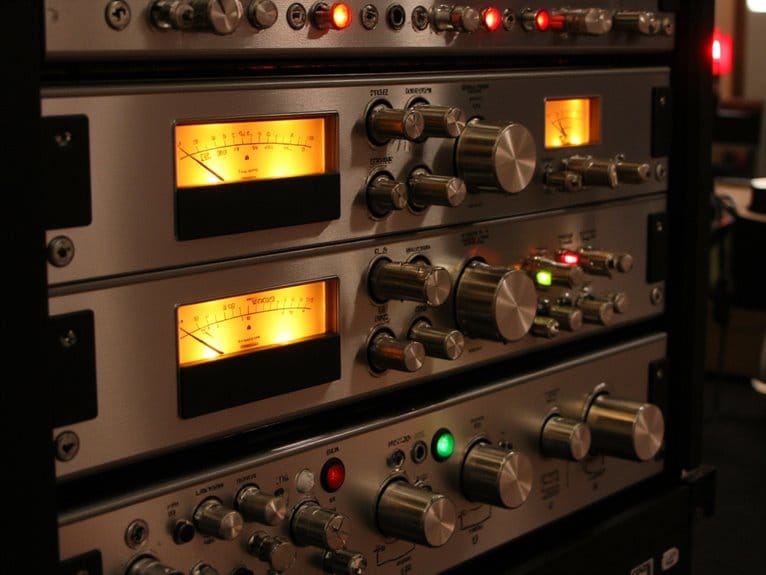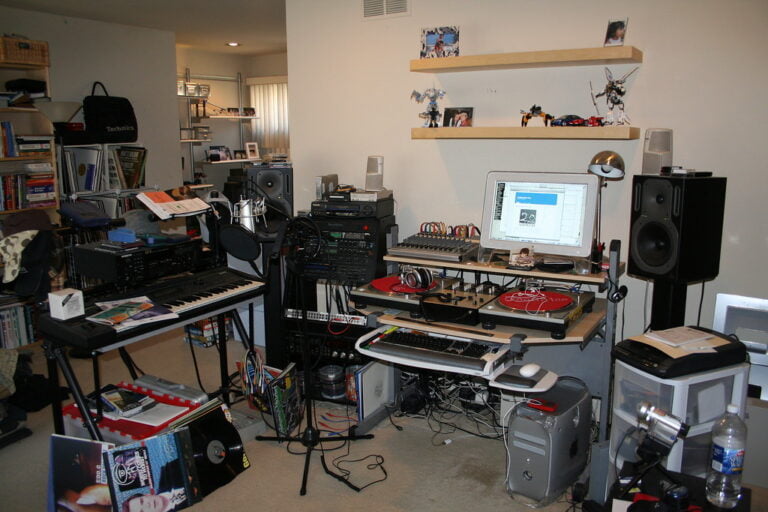Reverberation Tips: Adding Space to Your Mix
You’ll transform your reverb from basic ambience to professional depth by manipulating the tail through pitch shifting for harmonies, gating for punchy drum effects, and freezing sustained textures. High-pass filter your reverb around 80-120Hz to eliminate muddiness, then apply sidechain compression for dynamic ducking that maintains clarity. Sync your decay times with track BPM, use pre-delay to preserve transients, and route instruments through auxiliary channels for parallel processing that preserves your dry signals while building complex soundscapes that reveal advanced spatial techniques.
We are supported by our audience. When you purchase through links on our site, we may earn an affiliate commission, at no extra cost for you. Learn more.
Notable Insights
- Use auxiliary channels for reverb sends to maintain dry signal integrity and enable parallel processing control.
- High-pass filter reverb returns at 80-200Hz to prevent low-frequency muddiness and frequency masking in your mix.
- Align reverb decay times with your track’s BPM to enhance musical phrasing and spatial cohesiveness.
- Apply EQ before compression on reverb tails to prevent unwanted pumping effects and maintain clarity.
- Set pre-delay carefully to ensure reverb onset doesn’t blur transients while creating desired spatial depth.
Creative Reverb Tail Manipulation and Effects
While most producers treat reverb tails as passive afterthoughts that simply fade into silence, I’ve discovered that these sonic remnants can become powerful creative tools when you manipulate them with intention and precision.
Through pitch shifting effects, you can detach tails from dry signals, creating harmonies that complement your source material while adding musical depth.
Pitch-shifted reverb tails become independent harmonic elements, detached from their source to create complementary musical layers with enhanced dimensional depth.
Reverse reverb techniques involve flipping tail clips ahead of note onsets, generating smooth lead-ins that enhance shifts between sections.
Frozen tails transform standard reverb textures into sustained instrumental elements, particularly effective when compressed before freezing to boost quieter segments. Modern reverb pedals often include freeze functions that allow you to sustain these atmospheric textures indefinitely for creative manipulation.
Gated reverb controls tail decay abruptly, creating punchy effects perfect for drums, while layering techniques combine multiple processed tails for complex, evolving soundscapes through strategic tail manipulation. When working with crash sounds, extending the decay time to over 12 seconds creates expansive atmospheric textures that fill sonic space effectively. Pre-delay adjustments enable precise positioning of reverb glitches within your groove structure for enhanced sonic harmony.
For budget-conscious producers, true bypass technology in affordable reverb pedals ensures your original signal remains uncolored when the effect is disengaged, maintaining the integrity of your dry sound source.
Compression and EQ Strategies for Reverb Clarity
Because reverb processing becomes exponentially more complex when clarity issues arise, I’ve learned that strategic compression and EQ application can transform muddy, overwhelming reverb tails into pristine spatial elements that enhance rather than compete with your dry signals.
You’ll want to start with high-pass filtering around 80-120Hz to eliminate low-frequency muddiness that clouds your mix’s foundation.
Sidechain compression using your dry signal as the key input creates dynamic ducking, allowing reverb depth to swell between notes while maintaining clarity enhancement during active passages.
I typically use 4:1 ratios with fast attacks, removing 3-4dB from peaks to smooth the tail’s presence.
Apply EQ before compression to prevent unwanted frequencies from triggering pumping, then blend parallel processing to balance natural ambience with controlled dynamics. For plucky sources that generate harsh reverb artifacts, compress the signal with a high ratio and fast times before sending to reverb to target transients specifically and improve the overall reverb quality. Set your reverb plug-in to 100% wet when using return channels to maintain proper signal separation.
Timing, Decay, and Tempo Relationships
When reverb timing aligns with your track’s tempo, you’ll discover that spatial effects transform from distracting afterthoughts into integral musical elements that enhance rather than compete with your dry signals.
Converting your song’s BPM into milliseconds gives you precise reference points for pre delay adjustments, ensuring reverb onset doesn’t blur rhythmic transients.
I’ve found that decay synchronization works best when reverb tails clear before the next similar musical event, whether that’s a snare hit or vocal phrase. Musical phrasing benefits tremendously from tempo-matched decay times-slower songs accommodate longer washes while faster tracks demand tighter control.
These rhythmic enhancements require small adjustments, often just 10-20 milliseconds, but the difference in mix cohesion is immediately apparent. Proper equalization within your reverb settings prevents frequency masking between the wet signal and your original sources, maintaining clarity while adding the desired spatial character. The send and return setup allows for individual processing of each element with dedicated reverb parameters.
Signal Routing and Frequency Shaping Techniques
Although timing creates the foundation for musical reverb, proper signal routing determines whether your spatial effects enhance or muddy your mix. I’ve learned that understanding aux sends versus direct insertion makes the difference between amateur and professional results.
When you route signal paths through auxiliary channels, you’re preserving your dry tracks while creating parallel processing opportunities that maintain clarity. I’ve found that bus routing multiple instruments to shared reverb instances saves CPU while ensuring consistent spatial characteristics, though it requires careful layer blending to avoid frequency conflicts. Proper routing decisions significantly change the mix and enhance your creative sound sculpting capabilities when applying spatial effects.
Using aux returns allows independent EQ shaping of your reverb tails, where high-pass filtering around 200Hz prevents low-end buildup, and gentle low-pass cuts above 8kHz reduce harshness without sacrificing the atmospheric qualities you’re after. Understanding the complete signal flow path from your audio source through input processing to final output destination ensures your reverb effects reach their intended monitoring setup correctly.
On a final note
You’ve now got the essential reverb techniques that’ll transform your mixes from flat to dimensional. I’ve found that combining tail manipulation with strategic compression, while paying attention to decay timing relative to your track’s tempo, creates the most convincing spatial illusions. Remember, thoughtful signal routing and frequency shaping prevent reverb from muddying your mix-you’re sculpting space, not drowning your instruments in it.





